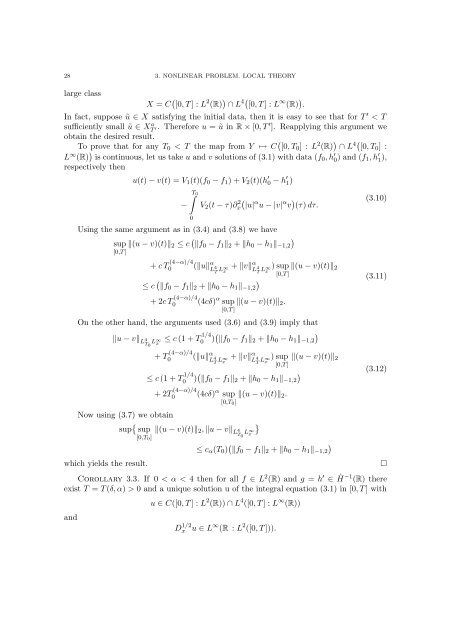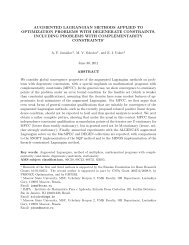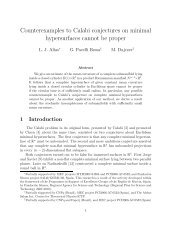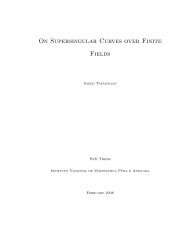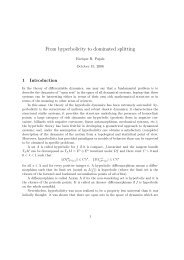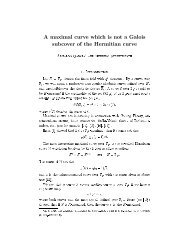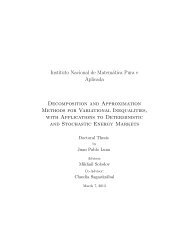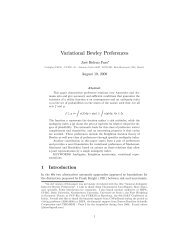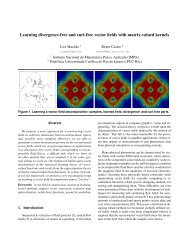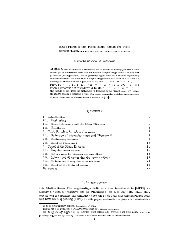Notes on Boussinesq Equation
Notes on Boussinesq Equation
Notes on Boussinesq Equation
You also want an ePaper? Increase the reach of your titles
YUMPU automatically turns print PDFs into web optimized ePapers that Google loves.
28 3. NONLINEAR PROBLEM. LOCAL THEORY<br />
large class<br />
X = C ( [0, T ] : L 2 (R) ) ∩ L 4( [0, T ] : L ∞ (R) ) .<br />
In fact, suppose ũ ∈ X satisfying the initial data, then it is easy to see that for T ′ < T<br />
sufficiently small ũ ∈ X a T ′ . Therefore u = ũ in R × [0, T ′ ]. Reapplying this argument we<br />
obtain the desired result.<br />
To prove that for any T 0 < T the map from Y ↦→ C ( [0, T 0 ] : L 2 (R) ) ∩ L 4( [0, T 0 ] :<br />
L ∞ (R) ) is c<strong>on</strong>tinuous, let us take u and v soluti<strong>on</strong>s of (3.1) with data (f 0 , h ′ 0 ) and (f 1, h ′ 1 ),<br />
respectively then<br />
u(t) − v(t) = V 1 (t)(f 0 − f 1 ) + V 2 (t)(h ′ 0 − h ′ 1)<br />
∫ T 0<br />
−<br />
0<br />
V 2 (t − τ)∂ 2 x(<br />
|u| α u − |v| α v ) (τ) dτ.<br />
Using the same argument as in (3.4) and (3.8) we have<br />
sup ‖(u − v)(t)‖ 2 ≤ c ( )<br />
‖f 0 − f 1 ‖ 2 + ‖h 0 − h 1 ‖ −1,2<br />
[0,T ]<br />
+ c T (4−α)/4<br />
0 (‖u‖ α L + 4 T L∞ ‖v‖α x L ) sup ‖(u − v)(t)‖ 4 2<br />
T L∞ x<br />
≤ c ( ‖f 0 − f 1 ‖ 2 + ‖h 0 − h 1 ‖ −1,2<br />
)<br />
[0,T ]<br />
+ 2c T (4−α)/4<br />
0 (4cδ) α sup ‖(u − v)(t)‖ 2 .<br />
[0,T ]<br />
On the other hand, the arguments used (3.6) and (3.9) imply that<br />
1/4<br />
‖u − v‖ L 4<br />
T0 L ∞ ≤ c (1 + T<br />
x 0 ) ( )<br />
‖f 0 − f 1 ‖ 2 + ‖h 0 − h 1 ‖ −1,2<br />
+ T (4−α)/4<br />
0 (‖u‖ α L + 4 T L∞ ‖v‖α x L ) sup ‖(u − v)(t)‖ 4 2<br />
T L∞ x<br />
[0,T ]<br />
≤ c (1 + T 1/4<br />
0 ) ( )<br />
‖f 0 − f 1 ‖ 2 + ‖h 0 − h 1 ‖ −1,2<br />
+ 2T (4−α)/4<br />
0 (4cδ) α sup ‖(u − v)(t)‖ 2 .<br />
[0,T 0 ]<br />
Now using (3.7) we obtain<br />
sup { }<br />
sup ‖(u − v)(t)‖ 2 , ‖u − v‖ L 4<br />
T0 L ∞ x<br />
[0,T 0 ]<br />
≤ c α (T 0 ) ( )<br />
‖f 0 − f 1 ‖ 2 + ‖h 0 − h 1 ‖ −1,2<br />
(3.10)<br />
(3.11)<br />
(3.12)<br />
which yields the result.<br />
□<br />
Corollary 3.3. If 0 < α < 4 then for all f ∈ L 2 (R) and g = h ′ ∈ Ḣ−1 (R) there<br />
exist T = T (δ, α) > 0 and a unique soluti<strong>on</strong> u of the integral equati<strong>on</strong> (3.1) in [0, T ] with<br />
and<br />
u ∈ C([0, T ] : L 2 (R)) ∩ L 4 ([0, T ] : L ∞ (R))<br />
D 1/2<br />
x u ∈ L ∞ (R : L 2 ([0, T ])).


